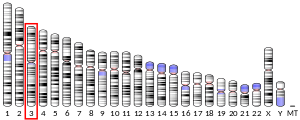KIF15
Kinesin family member 15 is a protein that in humans is encoded by the KIF15 gene.[5]
This gene encodes a motor protein that is part of the kinesin superfamily. KIF15 maintains half spindle separation by opposing forces generated by other motor proteins. KIF15 co-localizes with microtubules and actin filaments in both dividing cells and in postmitotic neurons.[5]
Function
KIF15 (also known as Kinesin-12 and HKLP2) is a motor protein expressed in all cells during mitosis and in postmitotic neurons undergoing axon growth.[6] KIF15 maintains bipolar microtubule spindle apparatus in dividing cells and shares redundant functions with KIF11.[7] KIF15 is thought to promote spindle assembly by cross-linking and sliding along microtubules creating a separation between centrosomes. The microtubule localization of Kif15 is being regulated by Kinesin binding protein (KBP).[8] HeLa cells depleted of KIF11, with reduced microtubule dynamics, are able to form bipolar spindles from acentrosomal asters in a KIF15 dependent manner.[9][10] Hence, inhibition of KIF15 function will be a vital therapeutic approach in cancer chemotherapy.[11] Since KIF11 and KIF15 are functionally redundant, drugs targeting both the proteins will be more potent.[8]
Function in neurons
KIF15 restricts the movement of short microtubules into growing axons by generating forces on microtubules which counteract those generated by cytoplasmic dynein.[12][13] KIF15, together with KIF23 become enriched in dendrites as neurons mature to promote the transport of minus-end distal microtubules into nascent dendrites.[12]
Interactions
KIF15 has been shown to interact with TPX2. Both these dimers cooperate to slide along microtubules and maintain bipolar spindles.[14][15]
References
- ENSG00000163808 GRCh38: Ensembl release 89: ENSG00000280610, ENSG00000163808 - Ensembl, May 2017
- GRCm38: Ensembl release 89: ENSMUSG00000036768 - Ensembl, May 2017
- "Human PubMed Reference:". National Center for Biotechnology Information, U.S. National Library of Medicine.
- "Mouse PubMed Reference:". National Center for Biotechnology Information, U.S. National Library of Medicine.
- "Entrez Gene: Kinesin family member 15".
- Buster DW, Baird DH, Yu W, Solowska JM, Chauvière M, Mazurek A, et al. (January 2003). "Expression of the mitotic kinesin Kif15 in postmitotic neurons: implications for neuronal migration and development". Journal of Neurocytology. 32 (1): 79–96. doi:10.1023/a:1027332432740. PMID 14618103.
- Vanneste D, Takagi M, Imamoto N, Vernos I (November 2009). "The role of Hklp2 in the stabilization and maintenance of spindle bipolarity". Current Biology. 19 (20): 1712–7. doi:10.1016/j.cub.2009.09.019. PMID 19818619.
- Sebastian J, Rathinasamy K (July 2019). "Benserazide Perturbs Kif15-kinesin Binding Protein Interaction with Prolonged Metaphase and Defects in Chromosomal Congression: A Study Based on in silico Modeling and Cell Culture". Molecular Informatics: minf.201900035. doi:10.1002/minf.201900035. PMID 31347789.
- Florian S, Mayer TU (October 2011). "Modulated microtubule dynamics enable Hklp2/Kif15 to assemble bipolar spindles". Cell Cycle. 10 (20): 3533–44. doi:10.4161/cc.10.20.17817. PMID 22024925.
- Dumont J (January 2012). "Bipolar disorder: kinesin-12 to the rescue". Cell Cycle. 11 (2): 212–3. doi:10.4161/cc.11.2.18785. PMID 22214669.
- Sebastian J (June 2017). "Dihydropyrazole and dihydropyrrole structures based design of Kif15 inhibitors as novel therapeutic agents for cancer". Computational Biology and Chemistry. 68: 164–174. doi:10.1016/j.compbiolchem.2017.03.006. PMID 28355588.
- Lin S, Liu M, Mozgova OI, Yu W, Baas PW (October 2012). "Mitotic motors coregulate microtubule patterns in axons and dendrites". The Journal of Neuroscience. 32 (40): 14033–49. doi:10.1523/JNEUROSCI.3070-12.2012. PMC 3482493. PMID 23035110.
- Liu M, Nadar VC, Kozielski F, Kozlowska M, Yu W, Baas PW (November 2010). "Kinesin-12, a mitotic microtubule-associated motor protein, impacts axonal growth, navigation, and branching". The Journal of Neuroscience. 30 (44): 14896–906. doi:10.1523/JNEUROSCI.3739-10.2010. PMC 3064264. PMID 21048148.
- Tanenbaum ME, Macůrek L, Janssen A, Geers EF, Alvarez-Fernández M, Medema RH (November 2009). "Kif15 cooperates with eg5 to promote bipolar spindle assembly". Current Biology. 19 (20): 1703–11. doi:10.1016/j.cub.2009.08.027. PMID 19818618.
- Vanneste D, Ferreira V, Vernos I (October 2011). "Chromokinesins: localization-dependent functions and regulation during cell division". Biochemical Society Transactions. 39 (5): 1154–60. doi:10.1042/BST0391154. PMID 21936781.
Further reading
- Courtois A, Schuh M, Ellenberg J, Hiiragi T (August 2012). "The transition from meiotic to mitotic spindle assembly is gradual during early mammalian development". The Journal of Cell Biology. 198 (3): 357–70. doi:10.1083/jcb.201202135. PMC 3413348. PMID 22851319.
- Oh SA, Allen T, Kim GJ, Sidorova A, Borg M, Park SK, Twell D (October 2012). "Arabidopsis Fused kinase and the Kinesin-12 subfamily constitute a signalling module required for phragmoplast expansion". The Plant Journal. 72 (2): 308–19. doi:10.1111/j.1365-313X.2012.05077.x. PMID 22709276.
- Dumont J (January 2012). "Bipolar disorder: kinesin-12 to the rescue". Cell Cycle. 11 (2): 212–3. doi:10.4161/cc.11.2.18785. PMID 22214669.
- Goshima G (2011). "Identification of a TPX2-like microtubule-associated protein in Drosophila". PLOS ONE. 6 (11): e28120. doi:10.1371/journal.pone.0028120. PMC 3227607. PMID 22140519.
- Ho CM, Hotta T, Guo F, Roberson RW, Lee YR, Liu B (August 2011). "Interaction of antiparallel microtubules in the phragmoplast is mediated by the microtubule-associated protein MAP65-3 in Arabidopsis". The Plant Cell. 23 (8): 2909–23. doi:10.1105/tpc.110.078204. PMC 3180800. PMID 21873565.
- Liu M, Nadar VC, Kozielski F, Kozlowska M, Yu W, Baas PW (November 2010). "Kinesin-12, a mitotic microtubule-associated motor protein, impacts axonal growth, navigation, and branching". The Journal of Neuroscience. 30 (44): 14896–906. doi:10.1523/JNEUROSCI.3739-10.2010. PMC 3064264. PMID 21048148.
- Gong Y, Ma Z, Patel V, Fischer E, Hiesberger T, Pontoglio M, Igarashi P (January 2009). "HNF-1beta regulates transcription of the PKD modifier gene Kif12". Journal of the American Society of Nephrology. 20 (1): 41–7. doi:10.1681/ASN.2008020238. PMC 2615735. PMID 19005009.
- Lee YR, Li Y, Liu B (August 2007). "Two Arabidopsis phragmoplast-associated kinesins play a critical role in cytokinesis during male gametogenesis". The Plant Cell. 19 (8): 2595–605. doi:10.1105/tpc.107.050716. PMC 2002617. PMID 17720869.
- Müller S, Han S, Smith LG (May 2006). "Two kinesins are involved in the spatial control of cytokinesis in Arabidopsis thaliana". Current Biology. 16 (9): 888–94. doi:10.1016/j.cub.2006.03.034. PMID 16682350.
External links
- Centrosome, 3D. "Centrosome 3D Consortium". Research Lab.
- "Research of Thomas Mayer". University of Konstanz. Archived from the original on 2013-02-03. Retrieved 2012-12-30.



